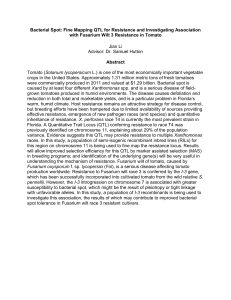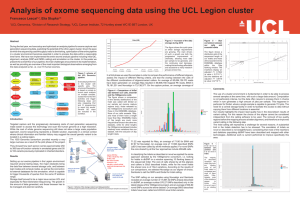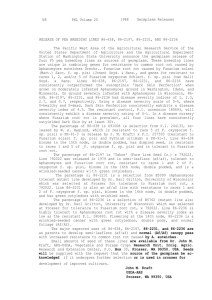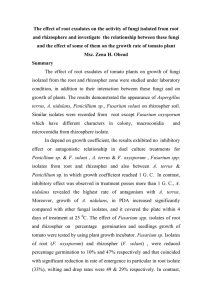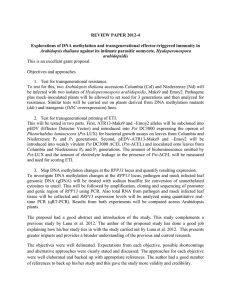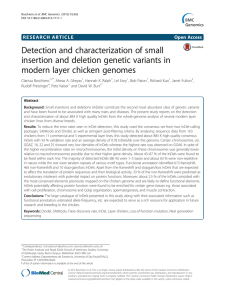Identifying Breeder-friendly INDELs that Co-segregate with SNP associated with QTL... Fusarium solani
advertisement
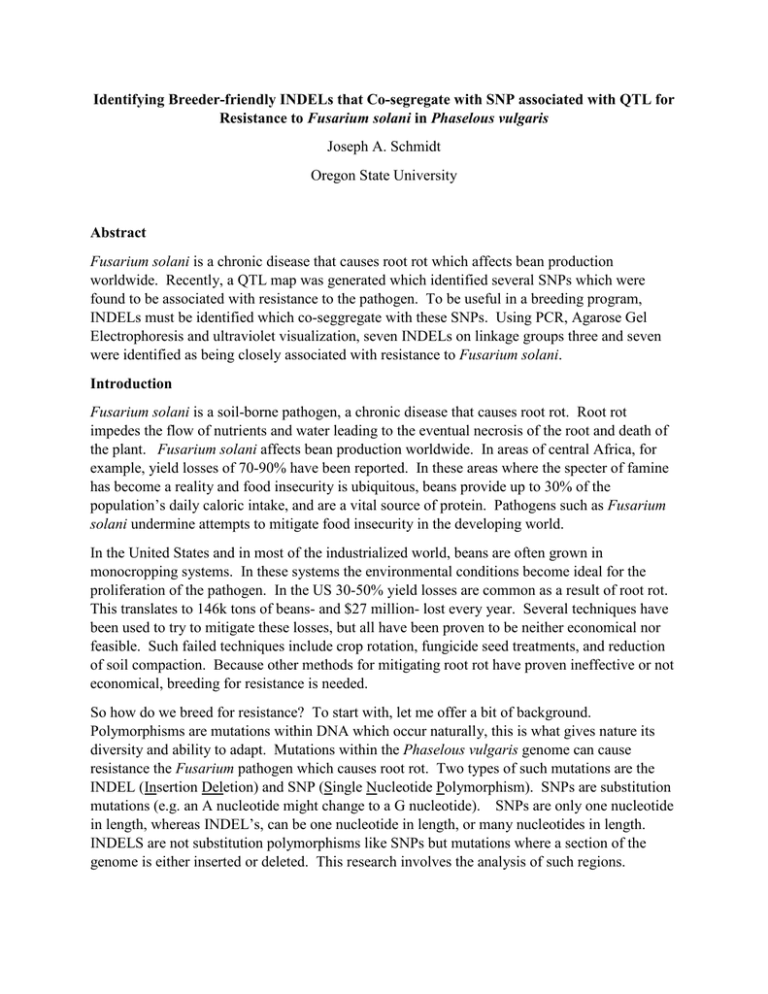
Identifying Breeder-friendly INDELs that Co-segregate with SNP associated with QTL for Resistance to Fusarium solani in Phaselous vulgaris Joseph A. Schmidt Oregon State University Abstract Fusarium solani is a chronic disease that causes root rot which affects bean production worldwide. Recently, a QTL map was generated which identified several SNPs which were found to be associated with resistance to the pathogen. To be useful in a breeding program, INDELs must be identified which co-seggregate with these SNPs. Using PCR, Agarose Gel Electrophoresis and ultraviolet visualization, seven INDELs on linkage groups three and seven were identified as being closely associated with resistance to Fusarium solani. Introduction Fusarium solani is a soil-borne pathogen, a chronic disease that causes root rot. Root rot impedes the flow of nutrients and water leading to the eventual necrosis of the root and death of the plant. Fusarium solani affects bean production worldwide. In areas of central Africa, for example, yield losses of 70-90% have been reported. In these areas where the specter of famine has become a reality and food insecurity is ubiquitous, beans provide up to 30% of the population’s daily caloric intake, and are a vital source of protein. Pathogens such as Fusarium solani undermine attempts to mitigate food insecurity in the developing world. In the United States and in most of the industrialized world, beans are often grown in monocropping systems. In these systems the environmental conditions become ideal for the proliferation of the pathogen. In the US 30-50% yield losses are common as a result of root rot. This translates to 146k tons of beans- and $27 million- lost every year. Several techniques have been used to try to mitigate these losses, but all have been proven to be neither economical nor feasible. Such failed techniques include crop rotation, fungicide seed treatments, and reduction of soil compaction. Because other methods for mitigating root rot have proven ineffective or not economical, breeding for resistance is needed. So how do we breed for resistance? To start with, let me offer a bit of background. Polymorphisms are mutations within DNA which occur naturally, this is what gives nature its diversity and ability to adapt. Mutations within the Phaselous vulgaris genome can cause resistance the Fusarium pathogen which causes root rot. Two types of such mutations are the INDEL (Insertion Deletion) and SNP (Single Nucleotide Polymorphism). SNPs are substitution mutations (e.g. an A nucleotide might change to a G nucleotide). SNPs are only one nucleotide in length, whereas INDEL’s, can be one nucleotide in length, or many nucleotides in length. INDELS are not substitution polymorphisms like SNPs but mutations where a section of the genome is either inserted or deleted. This research involves the analysis of such regions. Recently, a graduate at OSU, Christina Hagerty, finished her thesis mapping Quantitative trait Loci using SNPs, which were developed through the USDA funded Bean Coordinated Agricuture Program, or BeanCap. Her discovery work was with the factors which cause resistance, but because SNPs are difficult to implement in a breeding program, some more work was needed. The application of her findings is the premise of this research- which is the identification of the INDEL markers which co-segregate with the SNP’s in her findings. Plant breeders can use INDELs more efficiently than SNPs. In Phaselous vulgaris, there are 11 linkage groups. On the left is an illustration of one of those, linkage group 3. The chromosome is colored green. Notice the box-and-whisker plots adjacent to linkage group three-- FRROR11 is the QTL of interest to my work, the QTL for Fusarium resistance. Quantitative Trait Loci, or QTL are stretches of DNA containing genes that underlie a quantitative trait, such as Fusarium resistance. Mapping regions of the genome that contain genes involved in specifying a quantitative trait is done using molecular tags such SNPs. The SNP which is associated with Fusarium resistance on linkage group 3 is SNP0240. From the data I consolidated from vast excel spreadsheets from various sources, I have identified several INDEL candidates which are located in relatively close proximity to the SNP of interest, which is what is meant by “Co-segregation”. There are two linkage groups which have Quantitative Trait Loci for Fusarium resistance, linkage groups 3 and 7. Methods The DNA used in the research is from the same population used in generating the aforementioned QTL map. It was collected from the progeny of a recombinant inbred population whose parents have contrasting root rot resistance characteristics. OSU 5446, which is a Blue lake snap bean is very susceptible to root rot and RR6950, a tropical Black Bean is highly resistant to Root rot. The first step is to amplify the INDEL candidates using the DNA from each parent, using Polymerase Chain Reaction, or PCR. PCR is a method of amplifying segments of DNA using Primers (F and R), AmpliTaq polymerase, 10X buffer, dNTPs, and PCR water combined with the DNA. The primers I used in the PRC solution were primers for known INDELs from the BeanCAP Stampede/Redhawk population. The DNA/primer/polymerase solution is loaded into the thermocycler, the machine cycles through a series of temperatures which denatures the DNA strands at high temperatures and at lower temperatures the primers anneal, binding to complementary strands. At a third, intermediate temperature dNTPs provide nucleotides for the extension of DNA. This is how the INDEL is built and the process is repeated several times, exponentially increasing the number of INDELS each cycle. Once the INDEL of interest has been amplified, the next step is to visually identify the INDEL markers using Agarose gel electrophoresis. The gel solution is mixed with ethidium bromide, which binds to DNA and fluoresces under ultraviolet light. The gel is then placed in an electrophoresis rig with buffer solution. The machine runs an electric current through the gel, causing the INDELs to move slowly through the gel. The rate which they travel is directly proportional to their size. ( i.e. larger fragments move more slowly than smaller fragments) After a few hours, a photo can be taken with UV light at which time any size difference can be visualized. At this point the mutations which have been visualized have not been identified as INDELs associated with any particular QTL. In order to confirm that an INDEL is associated with resistance to Fusarium solani, DNA from the recombinant inbred population of OSU 5446 and RR6950 will be used. The ten most resistant of the progeny, along with the ten most susceptible of the progeny, will have DNA extracted and used in the next protocol. The process is similar to the one described earlier, with Polymerase Chain reaction followed by agarose gel electrophoresis, only the protocol is slightly different. Results After the agarose gels have been visualized using ultraviolet light, it became evident that many of the INDELs which were originally identified were not tightly linked with resistance to Fusarium solani. However, seven INDELs were identified as being closely associated with resistance. These INDELs reside on linkage groups three and seven: NDSU_IND_3_35.8829 NDSU_IND_3_31.2189 NDSU_IND_7_06.6340 NDSU_IND_7_08.1543 NDSU_IND_7_12.0240 NDSU_IND_7_09.1059 NDSU_IND_7_09.1228 Discussion Many of the INDELs which were originally identified were not tightly linked with resistance to Fusarium solani. These polymorphisms could be associated with any number of quantitative or qualitative traits, such as flower color, root angle or diameter, pod morphology, or even resistance to another pathogen. Because of time constraints, many of the INDEL candidates which were identified have not yet been screened, or confirmed in the progeny. It is probable that several more useful INDELs will be found. It should also be noted that Fusarium solani is not the only pathogen which causes root rot, but it is the primary cause of root rot in the Pacific Northwest. In bean production areas in Wisconsin, for example, Aphanomyces is the pathogen which is responsible for root rot. In other areas, Rhizoctonia is the cause. Future work should be done in identifying the markers associated with resistance to all of the pathogens which cause root rot, so beans can be bred accordingly.
